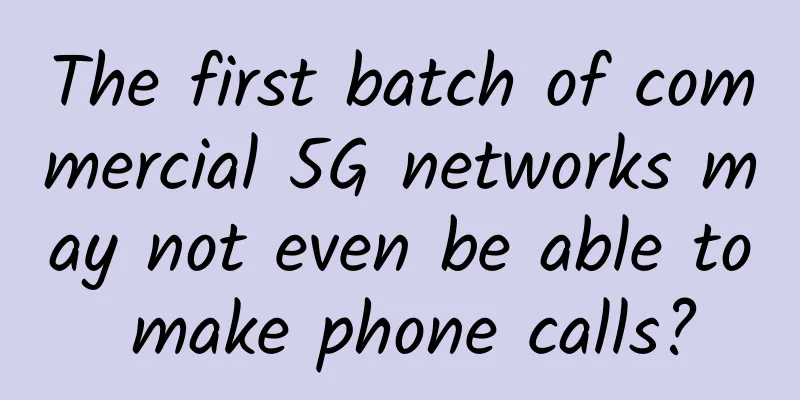The first batch of commercial 5G networks may not even be able to make phone calls?

|
01.Everyone is paying attention to the 5G Internet speed, but can 5G be used for phone calls? At the Barcelona Expo in 2019, 5G was the absolute protagonist, and various manufacturers showed off their unique capabilities. Some displayed innovative 5G chips, some displayed 5G mobile phones with Internet speeds of several G per second, and some displayed ultra-low latency and massively connected IoT services under 5G networks. It was really dazzling.
ZTE mobile phones at the 2019 Barcelona Expo However, no manufacturer has promoted the benefits of making calls on the 5G network. This is the most basic demand in the mobile communications industry, just like everyone must ensure sufficient supply of water and electricity, and there is really no highlight in the promotion. So, can we make calls on the 5G network?
The need to make phone calls is unchanging In fact, since the 4G era, the main service of wireless networks has been high-speed Internet access. The status of making phone calls, an indispensable need, has been quite low. Many 4G networks do not even support making phone calls. How can 5G, the arrogant darling of the times, be willing to do the low-end work that 4G doesn't even want to do? If 5G can’t even make phone calls, is it still worthy of being called 5G? Don’t worry, it’s not that 4G and 5G are incapable, but that they mainly provide high-speed Internet services, leaving voice services to the two big brothers 2G and 3G. Even without the backup of 2G and 3G, with the cooperation of other modules, the 5G network can still make calls, and the call quality can even be better. It’s just that 5G is not interested in this and is just passively slacking off. It is true that in the 5G era, we no longer care about voice services, but it is still and will always be the most basic demand and basic service of mobile communications and is indispensable. Let’s start with the development of voice services and explore how to make calls in the 5G era. 02. The rise of data services and the marginalization of voice services 1G: Mobile communications were born, with only voice services The phone was created to make calls, and in its early days, the mobile phone was a phone that could be carried around, so it was also called a mobile phone. In the 1G era, owning a mobile phone that could make calls anytime, anywhere was a sign of success.
2G: Popularization of mobile communications, voice services dominate, and data services begin to develop In the 2G era, mobile communications began to become popular. In the eyes of the public, mobile phones are used to make calls and send text messages. The network is the mobile phone connected to the base station (BTS) and base station controller (BSC) on the communication tower through wireless signals, and then connected to the core network (mainly MSC). At this time, the core network can only support making calls, so it can also be called the "voice core network." The original 2G network architecture: only supports making calls Every time you make a call, you need to establish a circuit from "mobile phone → base station → base station controller → core network". As long as the phone is on, even if you don't speak, this circuit is still reserved for you and provides services for you, so it will be charged by time. This service mode is called circuit switching, because in English it is Circuit Switch, also referred to as CS, and the core network is also called CS domain.
Circuit switching is very much like a tram, with exclusive use of the lines Later, in order to meet the then-unclear demand for Internet access, a group of experts modified the 2G network architecture and added some equipment, which enabled Internet access. 2.5G was born, also known as GPRS. GPRS once became the name used by operators to refer to mobile Internet access services.
To support GPRS, of course you have to replace your mobile phone with a new one. Not only can the mobile phone access the Internet, but it can also be connected to a computer. The computer can also access the Internet through the mobile phone. This was a very cool thing in that era. Base stations and base station controllers must be upgraded to support GPRS. The biggest change is the core network. In addition to the original voice core network (CS domain), a new data core network (PS domain) that supports Internet access has been added. Starting with GPRS, data core network emerged The full name of PS is Packet Switch. Suppose Lao Wang wants to send a short video to his girlfriend, the network will divide the file into many small data packets, each of which is sent independently and assembled at the destination. On a packet switching channel, data packets from many people can be sent at the same time, and resources can be shared. The advantage of this method is that the transmission resource utilization rate is high. The disadvantage is that if too many data packets are sent by multiple people at the same time, congestion is likely to occur, resulting in a very slow rate. It doesn't matter if a short video is sent slowly, at most you can wait a little longer to watch it, but it's not the same when making a phone call, because it's stuck and you can't hear anything clearly.
Packet switching is like a highway: multiple vehicles can share the road, improving resource utilization Therefore, in the 2G and 2.5G era, voice calls are suitable for circuit switching, and data services are suitable for packet switching. Circuit switching is like a tram, with exclusive tracks, and packet switching is like an ordinary highway, where many cars can share the lane. In the 2.5G GPRS era, data services were just the icing on the cake of voice services and seemed dispensable. At that time, it was very common for ordinary users to have a 30M data package per month, but they could not even use up the data in the previous month, which shows how slow the speed of 2.5G is. Feature phone that supports 2G Internet access 3G: The explosion of mobile communications, with voice and data services sharing an equal share In the 3G era, the network was enhanced in data services, but the architecture was basically the same as 2.5G, and it was also divided into CS domain and PS domain. However, with the growth of demand for data services, the rise of large-screen mobile phones, and the increasing demand for network speed, the importance of PS domain continued to increase. Relatively speaking, the demand for making phone calls did not change much, and CS domain began to be marginalized. Because the architecture of 3G and 2G are exactly the same and they share the same core network, they are often drawn together and do appear to be highly unified. The network architecture of 2G (supporting GPRS) and 3G is basically the same 4G: Data services exploded, while voice services were marginalized In order to cope with the surging traffic like a volcanic eruption, 4G made a bold decision: strengthen the data core network, abandon the voice core network, and focus on meeting the people's strong demand for Internet access. As a result, the network architecture has undergone earth-shaking changes. 4G network architecture: Abandoning the voice core network and reorganizing the data core network If even the voice core network is gone, what should a 4G mobile phone do to make a call? First, go to 2G and 3G! This process is called voice fall back, also known as CSFB (circuit switch fall back). In simple terms, when a 4G mobile phone makes a call, it must first switch to 3G or 2G, and then make the call through circuit switching. In the early days of 4G, if you wanted to make a call, you had to fall back to 2G or 3G. CSFB was very popular in the early stage of 4G network construction. However, 2G and 3G are already old and will be retired. What should we do? 4G still needs to solve the problem of making calls by itself. So a long-unknown network element came into everyone's view, which is IMS. The IMS architecture is somewhat complex, so just take a look IMS, also known as IP Multimedia Subsystem, can implement voice services in packet switching networks. 4G happens to only have packet switching PS domain. After combining with IMS, the problem of independent phone calls in 4G networks is effectively solved. Therefore, the voice service based on 4G is called VoLTE (Voice over LTE). VoLTE Architecture Well, at this point, 4G has grown up and can fully support the sky. At the same time, 5G has already entered the basin and is accumulating strength for its birth. 03.How does 5G realize the phone call function? In the early days of 5G, it mainly covered dense urban areas with large populations and high Internet demand. The coverage was not yet contiguous, and there was no 5G core network. Therefore, 4G was still needed to provide basic services, and 5G was just the icing on the cake. This 5G deployment method that requires 4G assistance is called "non-standalone networking (NSA)". The most typical 5G non-independent networking mode: Option 3x In the 5G non-independent networking mode, the mobile phone actually works with 5G and 4G at the same time. 4G is the boss. If there is 5G coverage, 5G will share the work of 4G. If there is no 5G, all traffic will be carried by 4G alone. Therefore, in this infancy of 5G, when it is still unreliable, basic services such as making calls will of course be provided by 4G. This brings us back to the two options for making calls on the 4G network mentioned earlier: voice fallback and VoLTE. The animation below shows that when IMS is not deployed, neither 5G nor 4G supports voice, so they have to fall back to 2G or 3G to make calls. Fallback to 2G/3G via 4G voice in 5G non-standalone networking If IMS is deployed, 4G can make calls directly through VoLTE without the need for 2G and 3G networks. In 5G non-independent networking, 4G is responsible for voice services In 5G standalone deployment (SA), because 5G works completely independently and no longer relies on 4G, let alone 2G and 3G, although the matter of making phone calls can be thrown to 4G for processing like non-standalone networking, it is still more efficient for 5G to handle it independently. Fortunately, like 4G, it is not difficult for 5G to support phone calls by connecting to IMS. 5G can also connect to IMS to support phone calls Although making phone calls on 5G networks is not so important, and the first batch of 5G base stations actually deployed may not support direct phone calls, it is still a milestone and worth commemorating. It was on January 17, 2019 that China Unicom and ZTE Corporation made a 5G call based on the 3GPP R15 standard protocol, allowing us to hear the voice of 5G and announcing the arrival of the new 5G era.
The 5G era is here |
<<: IT Viewpoint: Five major network challenges for 2019
>>: Is homogeneous competition among telecom operators serious?
Recommend
How can 5G development be realized?
[[375985]] [51CTO.com original article] "If ...
5G connectivity enables smart substations
[[423089]] Smart substations will be installed be...
SDN/NFV/CLOUD is too complex and AI and 5G accelerate the reconstruction of the network
Just like decoration in life, during the decorati...
The number of 5G package users far exceeds the number of 5G mobile phone users. Are you infected by 5G?
If we distinguish by telecommunications scale, th...
Zigbee vs. Wi-Fi: Which is Better for Your Smart Home?
All smart home appliances rely on connectivity to...
The industry's first enterprise 5G router was successfully commercialized, and Huawei Network Innovation Technology Forum was successfully held in Beijing
[Beijing, China, July 22, 2020] Today, at the Hua...
edgeNAT newly launched South Korea SK direct connection VPS with 20% discount on monthly payment and 30% discount on annual payment, 2G memory package starts at 48 yuan/month
edgeNAT has newly launched the Korean three-netwo...
Comprehensive analysis of SEO optimization: From HTML tags to Sitemap.xml, the techniques you must know
In the digital age, acquiring website traffic dep...
GreenCloudVPS 9th anniversary, $15/year KVM-2GB/20GB/2TB/San Jose and other data centers available
GreenCloudVPS recently launched its 9th anniversa...
After the construction of 5G, 4G Internet access on mobile phones has become slower. Is this really a marketing trick of the operators?
Preface [[332244]] Recently, many customers and f...
Aruba Launches First-Ever Asset Tracking Solution to Improve Workforce Efficiency and Customer Experience at a Low Cost
The solution uses new Bluetooth Low Energy (BLE) ...
Illustrated DHCP protocol, understand how your computer/mobile phone automatically obtains IP
Hello everyone, I am Bernie, an IT pre-sales engi...
Tencent Interview: Do you understand process communication?
[[432787]] This article is reprinted from the WeC...
The past and present of AlphaGo
Why did AlphaGo focus on Go instead of Mahjong? L...
The details of number portability have been announced, but these four types of numbers cannot be ported
Recently, the long-awaited number portability has...









